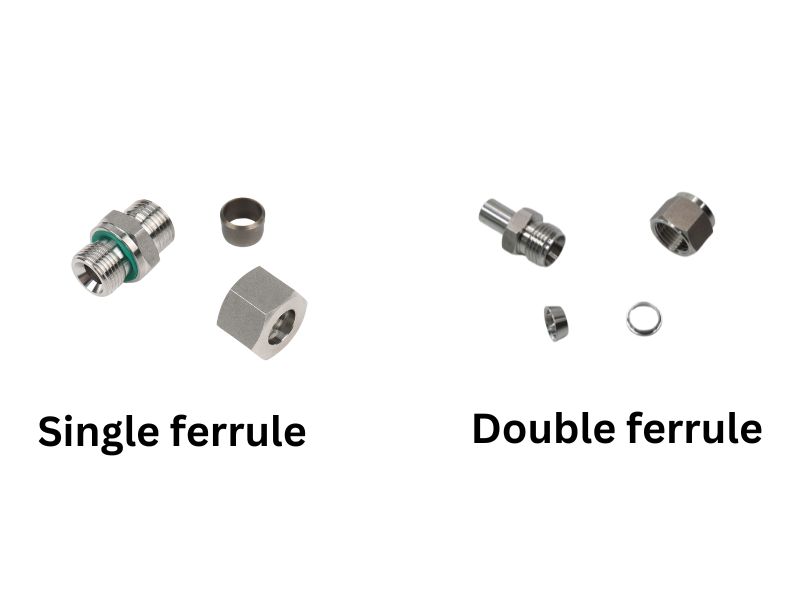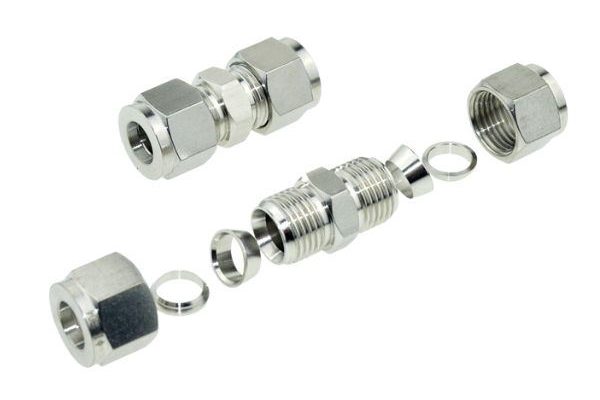Tube fittings play a key role in ensuring the efficient and safe transportation of fluids and gases in a variety of industrial environments. The purpose of this article is to introduce two major types of tube hydraulic fittings that play a key role in such systems. As we delve into the intricacies of each type of tube fitting, we will explore their unique characteristics, applications, and key differences that distinguish them. This guide is not only a primer, but also a comprehensive resource for those who wish to gain a deeper understanding of these important industrial components.
Tube pipe fittings are critical components in various industrial systems, designed to securely connect tubing sections in fluid and gas systems. Their primary function is to ensure a leak-proof and secure connection, maintaining the integrity and efficiency of the system. These fittings find their applications in a range of settings, from manufacturing plants to hydraulic systems, where they play a vital role in controlling and directing the flow of substances.
Tube hose fittings must be reliable and robust, capable of withstanding high pressures and diverse environmental conditions. They are manufactured with precision to ensure that they can handle the specific requirements of different industrial applications, including temperature fluctuations and chemical exposures.
Understanding the difference between tube hose fittings and pipe fittings is crucial for proper application. Tube pipe fittings are generally used for smaller, more precise connections and are essential where space and weight are significant factors. Pipe fittings, on the other hand, are suited for larger-scale applications and often involve threaded connections for installation. This distinction is critical in industrial settings where the choice between tube and pipe fittings can impact the overall efficiency and safety of the system.
The use of appropriate tube adapters is not just a matter of efficiency but also safety. Incorrect or inadequate fittings can lead to leaks, which in industrial environments can have serious consequences, including system failures, environmental damage, and safety hazards.
Tube compression fittings, essential in fluid systems, function by securing the tubing with a compression mechanism. This design typically involves a body, a ferrule, and a nut. As the nut is tightened, the ferrule is compressed onto the tube, creating a tight seal. This mechanism is crucial in ensuring a leak-proof and secure connection, which is fundamental in various industrial applications.
The primary advantage of these fittings is their ability to create a robust, leak-proof connection, vital in maintaining system integrity. These fittings are valued for their durability, especially in systems subject to vibration or thermal changes. Another key benefit is the ease of installation and maintenance, making them a practical choice in many industrial settings.
Compression tubepipe fittings are versatile and find applications in a broad range of industries. Their reliability in sealing and ease of use make them ideal for sectors like oil and gas, pharmaceuticals, and manufacturing. They are particularly useful in hydraulic and pneumatic systems, where secure and leak-proof connections are critical.
Understanding the role and benefits of compression tube pipe fittings is crucial for professionals in industries relying on fluid systems. Their reliability, ease of use, and versatility make them a staple in industrial applications, ensuring efficiency and safety in operations.
Double ferrule tube hydraulic fittings are recognized for their robust construction and reliability in industrial applications. These fittings, comprising two separate ferrules, provide a dual-sealing action. The front ferrule seals the tubing, preventing fluid or gas leaks, while the back ferrule anchors the tubing securely in place. This dual action is essential in maintaining both the integrity and safety of tubing systems in various industries.
One of the key advantages of double ferrule fittings is their performance under high-pressure conditions. The unique design, with two points of sealing and gripping, ensures a more stable and secure connection than single ferrule fittings. This makes them highly suitable for applications involving high-pressure fluids or gases.
Double ferrule fittings are versatile and can be found in a myriad of industrial settings. They are particularly prevalent in sectors like oil and gas, petrochemical, and pharmaceutical industries, where leak-proof and secure connections are crucial. Their ability to handle different types of fluids and gases under various temperature and pressure conditions makes them indispensable.
When compared with other types of fittings, such as single ferrule or flare fittings, double ferrule fittings offer enhanced reliability. This is especially important in applications where safety is paramount, and leakage can lead to significant hazards or system failures.
The dual-sealing mechanism of double ferrule tube hose fittings provides unparalleled reliability and safety, making them a preferred choice in many high-stakes industrial applications. Their ability to maintain integrity under challenging conditions positions them as a key component in modern industrial setups.

Single ferrule tube pipe fittings are fundamental components in many industrial tubing systems, offering a simple yet effective means of securing tubes. Comprising of a body, a nut, and a single ferrule, these fittings function by exerting pressure on the tube when the nut is tightened. This pressure causes the ferrule to compress around the tube, creating a tight seal that prevents leaks and ensures a stable connection.
The simplicity of single ferrule fittings allows for easier and faster installation compared to more complex fitting types. This is particularly advantageous in systems where quick assembly or frequent reconfiguration is needed. Moreover, their streamlined design means fewer parts to manage, reducing the risk of incorrect assembly and maintenance challenges.
Single ferrule fittings are widely used across various industries due to their effectiveness in creating secure connections in tubing systems. They are particularly prevalent in manufacturing, where they are used in fluid control systems, and in the automation industry, where they are essential in pneumatic controls. Additionally, these fittings are common in hydraulic systems in heavy machinery, where they ensure reliable operation under high pressure.
In comparison with double ferrule or other multi-component fittings, single ferrule fittings offer a more straightforward and cost-effective solution. While they may not provide the same level of security as double ferrule fittings, particularly in high-pressure environments, their ease of use and efficiency make them an ideal choice for many applications where extreme conditions are not a factor.
The selection of materials for tube fitting is a critical decision in industrial applications, with choices ranging from stainless steel and brass to other alloys. Each material offers unique properties and benefits. Stainless steel, known for its robustness and excellent resistance to corrosion and heat, is often chosen for demanding environments. Brass, with its superior malleability and resistance to corrosion, is preferred in less rigorous conditions and is known for its compatibility with water and gas applications.

Material choice significantly affects both the application and durability of tube connectors. For instance, stainless steel fittings are ideal for high-pressure and corrosive environments, such as in chemical processing or marine applications. Brass fittings, while not suitable for high-pressure environments, are perfect for plumbing and heating systems due to their ease of installation and corrosion resistance.
Selecting the right material for tube hydraulic fittings involves considering factors like the nature of fluids or gases being transported, environmental conditions, temperature, and pressure. This careful consideration ensures that the fittings not only perform optimally under given conditions but also last longer, reducing maintenance and replacement costs.
In addition to performance, compatibility of the fitting material with the system it will be used in is crucial. Incompatible materials can lead to failures or system contamination. For instance, stainless steel is often chosen for its compatibility with a wide range of chemicals and its ability to maintain purity in sensitive systems like in pharmaceutical manufacturing.
Proper installation of tube hydraulic fittings is critical for the functionality and safety of any industrial system. It starts with selecting the right fitting for the tubing, ensuring compatibility in size and material. Before installation, inspect the tubing for any damage and ensure it is cut straight without burrs. While installing, follow the manufacturer’s instructions meticulously, particularly regarding the tightening torque. Over-tightening can cause damage, while under-tightening can lead to leaks. It’s also essential to ensure that the tube is properly inserted into the fitting before tightening to achieve a secure connection.
Regular maintenance of tube hydraulic fittings is key to the longevity and reliability of industrial systems. Schedule routine inspections to check for signs of wear, leaks, or corrosion. It’s important to address any issues promptly to prevent system failures. For cleaning, use appropriate solvents that won’t damage the fitting material. If disassembly is required, mark the orientation of the components to ensure correct reassembly. When re-tightening fittings, refer to the manufacturer’s guidelines to avoid over-tightening or under-tightening.
Adopting best practices for the upkeep of tube adapters involves keeping a record of maintenance schedules, replacements, and inspections. Training personnel on the correct handling and installation techniques is also crucial. Regular training ensures that everyone is up-to-date with the latest standards and practices.
By adhering to these guidelines for installing and maintaining tube hydraulic fittings, you can ensure the safety, efficiency, and longevity of your industrial systems. Proper installation and maintenance not only prevent costly downtime but also maintain the integrity of the system, ensuring a safe working environment.
In industrial settings, it’s imperative to quickly identify and address common problems withtube hydraulic fittings. These issues may range from leaks, caused by improper fitting or seal degradation, to blockages from debris or corrosion. Timely recognition of these issues is essential to maintain system integrity and prevent costly downtimes.
Effective troubleshooting in tube hydraulic fittings involves several strategies. Initially, conduct regular visual inspections to detect leaks or signs of wear and tear. If a leak is found, inspect the fitting for proper alignment and tightness. In cases of blockages, disassemble the fitting and inspect for any foreign material that may be causing the obstruction. For corroded fittings, assess whether cleaning or complete replacement is necessary.
When addressing common problems, it’s important to follow a systematic approach:
Leakage: Check if the fittings are correctly tightened. If the leak persists, replace any worn-out seals or the entire fitting if necessary.
Blockage: Clean the fitting thoroughly. Ensure that the tubes are free from debris before reassembly.
Corrosion: Assess the extent of corrosion. If superficial, clean and apply protective coatings; if severe, replace the fittings.
Preventive measures are key in avoiding common issues. Use the right type of fittings for the specific application, considering factors like pressure, fluid type, and environmental conditions. Ensure that all installations are done as per manufacturer guidelines and conduct regular training for staff handling these installations.
Regular maintenance and prompt troubleshooting are vital in ensuring the long-term functionality of tube hydraulic fittings in industrial settings. By adhering to these guidelines, you can significantly reduce the likelihood of system failures and ensure operational efficiency.
In summing up our exploration of tube hydraulic fittings, it’s evident that both single and double ferrule fittings play crucial roles in industrial applications. They ensure secure and efficient operations in various systems by providing reliable connections. Single ferrule fittings offer simplicity and ease of use, making them ideal for less demanding applications, while double ferrule fittings provide enhanced security, making them suitable for more critical, high-pressure environments. Their correct selection, installation, and maintenance are essential for the safety and effectiveness of industrial systems, underlining the importance of a thorough understanding of these components in any industrial setting.